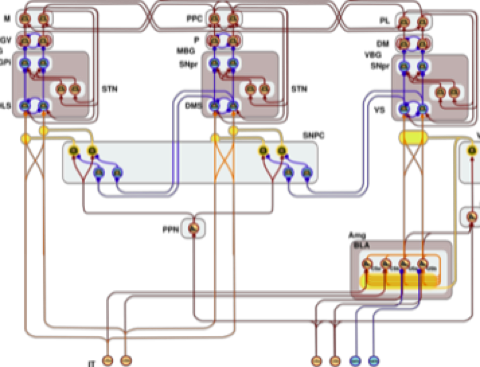If you could see the film of your life, you would first see a curious baby learning basic actions by interacting with the environment, then a child mastering increasingly complex actions, then a teenager in a storm of emotions and body sensations, and finally an adult exhibiting a fully developed goal-directed behaviour. If you could give a look into your brain you would see 100 billions of neurons connected with tiny "wires" in total longer more than two times the earth circumference. Strange as it might appear, it is this intricate and apparently messy neural circuit that is responsible for the film of your life. How? At ISTC the Laboratory of Computational Embodied Neuroscience (LOCEN) is working to answer this question.
Food, sex and rock 'n' roll: this might well be the motto of complex organisms such as primates. Evolution has built a sophisticated motivational machinery in their brains that drives their learning processes,allowing them to flexibly adapt to the ever changing challenges posed by the environment.
Fundamental motivations, driven by neuromodulators such as dopamine and noradrenaline, are related to the achievement of biological rewards, such as food and mates for reproduction. In more complex organisms, evolution has built in also motivational mechanisms that drive the acquisition of an increasingly complex repertoire of knowledge and skills, clearly visible in children at play: curiosity, fun, the pleasure of learning (rock 'n' roll).
Under the drive of these motivations the billions of neurons in your brain process the information from your eyes, ears and skin, and exploit them for learning how to act and to achieve your ever-changing goals in different contexts. To this purpose, actions are organized in the brain in a hierarchical and modular fashion so that they do not interfere with each other. Instead, they can be easily adapted to new conditions and can be flexibly assembled for acquiring increasingly complex behaviors.
The mission of the Laboratory Of Computational Embodied Neuroscience (LOCEN) is to understand the brain mechanisms behind these processes by reproducing them with computational models. The approach followed is highly interdisciplinary. The architecture and functioning of the models are built on the basis of the available neuroscientific knowledge about the anatomy and physiology of real brains. The resulting structures are therefore required to reproduce the behaviours and the learning processes exhibited by real organisms in psychological experiments and ethological observations. This allows to understand the general principles of brain organization and functioning behind behaviour, and to produce detailed predictions that can be then tested in new experiments.
LOCEN believes that behaviour is acquired and produced by the brain via the interaction with the environment and with the internal body itself, mediated by the body sensors and the actuators. For this reason, the models it builds are often embodied in simulated organisms or even real robots (such as the humanoid robot "iCub"), and are situated in simulated or real environments as those of the experiments with real organisms.
Contacts: Gianluca Baldassarre, Marco Mirolli
ISTC Group: Laboratory Of Computational Embodied Neuroscience
Relevant Publications
Caligiore D., Borghi A., Parisi D., Baldassarre G. (2010). TRoPICALS: A Computational Embodied Neuroscience Model of Compatibility Effects. Psycological Review vol. 117, n. 4, pp. 1188-1228.
Mannella F., Mirolli M., Baldassarre G. (2010). The interplay of pavlovian and instrumental processes in devaluation experiments: a computational embodied neuroscience model tested with a simulated rat. In Tosh Colin and Ruxton Graeme (eds), Modelling Perception With Artificial Neural Networks, pp. 93-113. Cambridge, Cambridge University press.


